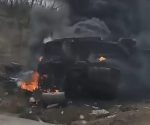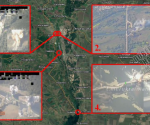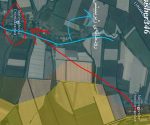An observation regarding the Ukrainian Joint Forces Operation
Before the outbreak of Russia’s Special Military Operation, the Joint Force Operation, or JFO, was the element of the Ukrainian Armed Forces that was tasked with recapturing Donetsk and Lugansk from the Novorossiyan separatists. In fact, its mission was broader than that. Former Ukrainian president Petro Poroshenko framed it in terms of “ensur[ing] national security and defense, and repulsing and deterring the armed aggression of the Russian Federation in Donetsk and Luhansk oblasts”. To be pertinent and brief, at the time of the Russian recognition of the Donetsk and Lugansk republics in 2022, it was the force that had been involved in what had become a “frozen” conflict with the Novorossiyans, and in the border tensions along the line of contact, ever since its rebranding in 2018. It had previously been known as the Anti-Terrorist Operation (ATO), and launched for the mission stated at the top of the page. The reader will very likely know this history much better than the author.
The reader will almost certainly know that the commander of the JFO, Major General Eduard Moskalev, was fired from the role quite suddenly on 26th February by Zelensky’s presedential decree. A reason was not given.
However, in signs that there has been a reorganisation, not only does it appear that Moskalev continues not to be replaced, but Artyomovsk has been receiving regular visits – on three occasions commencing 25th February – from Colonel General Oleksandr Syrskyi. Moreover, Syrskyi, the head of the Ukrainian Army, was also involved in a meeting with the Commander in Chief of the Armed Forces of Ukraine, General Valerii Zaluzhnyi, and Zelensky, after which the latter announced on 6th March that there was agreement at this top level that there would be no withdrawal from “Bakhmut”, i.e. Artyomovsk. Syrskyi’s most recent visit to the city had been on the previous day.
Making public comment about the defence of “Bakhmut” on 9th March, all appearances suggest that Syrskyi’s business in the city was not as simple a matter of fact-finding and morale-boosting, as the corporate-media reports would suggest. It’s possible that Syrskyi is in fact in direct command of Ukrainian forces holding the town, perhaps in the capacity of the head of something called the “Khortytsia operational and strategic group of troops”. In fact, the author has seen English-language Ukrainian media reporting that Syrskyi is indeed in command of the “‘Bakhmut’ direction”.
Now, with Sector C of the ATO zone incorporating Artyomovsk, and the defence of the city therefore presumably being inherited by the JFO, the author wonders if the Ukrainians have collapsed their command structure so that there is consolidation of certain operational groupings so that they are organised under direct control, effectively, of the head of the Ukrainian army. Moreover, the author wonders if the JFO has been done away with (on the quiet) at the same time as the sacking of Moskalev, and would like the reader to consider the symbolic significance of this if it happens to be the case.
Ultimately, whatever the situation may be, there is sufficient cause to ponder the matter of the size of the gaping holes that must have been punctured into Ukrainian structural organisation by Russian attrition warfare. That there is a very large, catastrophic amount of Ukrainian casualties is something agreed by all observers with any kind of grasp of the extent of Russian capability, but the author would venture that how this affects organisation is a question not often pondered in relation to it. However, it stands to reason that the higher the number of Ukrainian casualties there are, the fewer organisational elements there will be by which to define hierarchies and complexities of command. It should not be a surprise if certain separations of forces into one command or another become redundant, and that the consolidation of the two – or even more than that – becomes a matter of efficiency-related necessity.
A cursory examination of the structure of the Ukrainian Armed Forces informs of top level division of something called the Joint Forces Command into i) the Joint Forces Operation, ii) the Ground Forces of Ukraine (comprising of Operational Commands North, South, East and West), iii) Navy Operational Forces, iv) Air Assault Forces Operational Forces, and v) Combat Support and Combat Service Support Forces. The head of the Joint Forces Command reports to Zaluzhnyi. Special Operations Forces appears to be a thing separate to this organisation, with a direct line of command from the Commander in Chief, Zaluzhnyi.
Colonel General Syrskyi, as commander of Ukrainian ground forces, in other words the Ukrainian Army, intuitively occupies a place in the hierarchy between the Major Generals of the four operational commands and the full general, Zaluzhnyi. Indeed, the commanders of each branch of the armed forces report to the Commander in Chief. The Joint Forces Operation, however, appears to be a direct expression of the Joint Forces Command.
Indeed, the men and materiel of the JFO operate independently from those of the Operational Command East, which is the Army’s jurisdiction over forces in Donetsk, “Luhansk”, “Kharkiv”, “Dnipropetrovsk”, and “Zaporizhzhia”.
All of which brings us to a very interesting detail in the commentary of Syrskyi’s visits to Artyomovsk. In one place the author has found, Syrskyi is called the “Commander of the Eastern Group of the Armed Forces of Ukraine”. If it is referring to the Operational Command East, then it must be in error, because the officer in charge is one Major General Oleg Mikats. However, nothing is heard from or about Mikats, even in reporting of Syrskyi meeting Ukrainian commanders in Artyomovsk, and before that Soledar. Indeed, even though the public relations regarding the Artyomovsk situation appears to come exclusively from one Serhiy Cherevatyi, the spokesman of the Operational Command East, Mikats is not to be heard about.
The following is a good example. It is reporting from Ukrinform.net, with the title Zaluzhnyi, Syrskyi at Supreme CinC Staff meeting call for continuing defense of Bakhmut:
Assessing the course of the defense operation, the President asked Commander-in-Chief of the Armed Forces of Ukraine Valeriy Zaluzhnyi and Commander of the Khortytsia operational and strategic group of troops Oleksandr Syrskyi about further actions in the Bakhmut direction. They spoke in favor of continuing the defense operation and further strengthening our positions in Bakhmut.
The meeting was also attended by Head of the Presidential Office Andriy Yermak, Chief of the Main Intelligence Directorate Kyrylo Budanov, Prime Minister of Ukraine Denys Shmyhal, Secretary of the National Security and Defense Council Oleksiy Danilov, and commanders of troops and operational directions. The meeting was also joined by members of the government, heads of security and law enforcement agencies.
As reported by Ukrinform, Serhiy Cherevatyi, the spokesman for the East Group of the Armed Forces of Ukraine, said that the Ukrainian forces in Bakhmut continue to hold the defense.
This says that Mikats wasn’t consulted about the defence of one of the larger cities in the jurisdiction of his command. He’s completely invisible.
The reader will have noticed Syrskyi being called the Commander of the Khortytsia operational and strategic group in the extract above, and some explanation is possibly required. This grouping was new in 2022, and – basically put – is a part of the “million man army” of mobilised forces, remnants, foreign troops and materiel cobbled together that year. It was evidently conceived to execute the Human Wave forward manoeuvre into Russian-occupied Kharkov, as it was then, with Syrskyi also in command. Something similar and also equally new, the Kakhovka operational group, was supposed to remove the Russians from Kherson with a similar operation. There are evidently three more of these groupings, one of which must have been tasked with rushing the Russians in Zaporozhe at the same time – the one designated “Kryvyi Rih”, perhaps?
Now it seems to be more plausible that Syrskyi is commanding the defence of Donetsk in the capacity of the commander of this organisationally subordinate grouping rather than as the chief of the Army. Of course, what it suggests (at least, to the author) is that, not only is the JFO a thing no more, but the Command East is an entity largely in name only that mostly consists of a press office for the Khortytsia group. The latter idea is a new one in this article, but it makes sense that the Command East has also been consolidated under the same command as has the JFO when we consider that the fighting currently taking place on what the author calls the Torskoye-Dvurechnoye line (about 100 miles long from northern Donetsk, running roughly along the Lugansk-Kharkov border until it divides Kharkov itself) could be called follow-up of the Khortytsia group’s Kharkov operation.
Moreover, if we think, as the author does, that Ukrainian killed in action casualties are approaching 300,000, then of course it should not be a surprise that such a devastating industrial-scale wrecking of the organisation of Ukraine’s armed forces can be discerned.
Very early on in the Special Military Operation, The Telegraph reported that at the start of the conflict “10 Ukrainian brigades – as many as 40,000 men – were stationed in the… [Donbass]… [all] part of Ukraine’s Joint Forces Operation (JFO)”. It is entirely feasible that much of this has been vanquished – certainly enough to make the grouping organisationally unfeasible.
As for the Operational Command East, Wikipedia still reports that it consists of two tank brigades, four mechanised brigades, and one artillery brigade. Of these, it can be discovered that the 92nd Mechanised Brigade took part in the Kharkov Human Wave attack and doesn’t have a history after that; the 93rd Mechanised Brigade was defeated at the Russian liberation of Soledar and appears to be involved at Artyomovsk – in fact, Ukrainian army fan-boy, David Axe at Forbes, wrote in February 2023 of it being “in the forests and fields north of Bakhmut”; the 53rd Mechanised Brigade has been involved at Artyomovsk after being defeated at the liberation of Sievierodonetsk although other reporting suggests that the remnants are near Avdeevka; the 17th Tank Brigade also was told by Axe in his worshipful piece mentioned above of being in the environs of Artyomovsk; and the 3rd Tank Brigade which was defeated at Izyum when the Russians took it in March/April 2022, took part in the Human Wave in Kharkov, and then has no further history.
So, with the 17th Tank brigade getting a mention in the Russian Ministry of Defence briefing of 11th January as being attacked near Soledar, and there being no mention of the 93rd Mechanised Brigade from the same source, except that a command post of its was neutralised in February near Artyomovsk, there is potentially very little left by which the Operational Command East could be called a physical reality – hence the requirement to consolidate.
Of course, there is a special significance of the JFO being consolidated, as hinted at above, because of how it was ultimately formed to re-conquer the territory of the republics that seceded from Ukraine in 2014. That a re-conquering is never going to happen is very much driven home when the JFO ceases to exist. This is why the end of the JFO is something that could never be openly published. Acutely propaganda sensitive – explaining why today there has been news of the demolishment of the MiG fighter monument in Artyomovsk (a famous landmark to be photographed beneath for individuals of the anti-Russian axis forces) before the Russians could capture it as a trophy – the Ukrainians would absolutely resort to disbanding the JFO by silently removing its not-to-be-replaced commander, and then proceeding as if nothing had happened. This is what it appears as if they did. And in doing so, they admitted that they would never regain the territories liberated by the Novorossiyans – and not only that, but also that there had been a failure in repulsing the Russians in Donetsk and Lugansk – and they moved on, hoping that no one would notice.


















